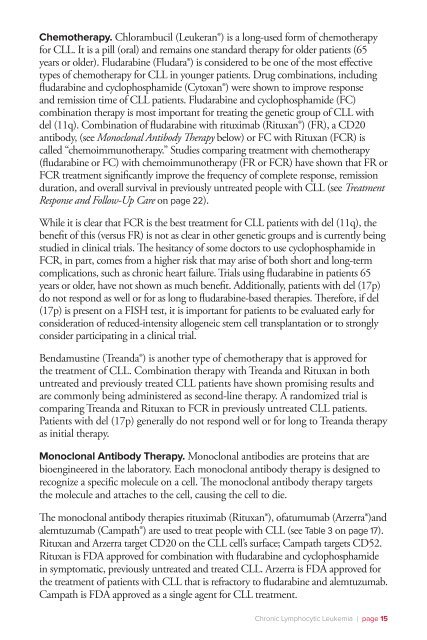Chronic Lymphocytic Leukemia - The Leukemia & Lymphoma Society
Chronic Lymphocytic Leukemia - The Leukemia & Lymphoma Society
Chronic Lymphocytic Leukemia - The Leukemia & Lymphoma Society
You also want an ePaper? Increase the reach of your titles
YUMPU automatically turns print PDFs into web optimized ePapers that Google loves.
Chemotherapy. Chlorambucil (Leukeran®) is a long-used form of chemotherapy<br />
for CLL. It is a pill (oral) and remains one standard therapy for older patients (65<br />
years or older). Fludarabine (Fludara®) is considered to be one of the most effective<br />
types of chemotherapy for CLL in younger patients. Drug combinations, including<br />
fludarabine and cyclophosphamide (Cytoxan®) were shown to improve response<br />
and remission time of CLL patients. Fludarabine and cyclophosphamide (FC)<br />
combination therapy is most important for treating the genetic group of CLL with<br />
del (11q). Combination of fludarabine with rituximab (Rituxan®) (FR), a CD20<br />
antibody, (see Monoclonal Antibody <strong>The</strong>rapy below) or FC with Rituxan (FCR) is<br />
called “chemoimmunotherapy.” Studies comparing treatment with chemotherapy<br />
(fludarabine or FC) with chemoimmunotherapy (FR or FCR) have shown that FR or<br />
FCR treatment significantly improve the frequency of complete response, remission<br />
duration, and overall survival in previously untreated people with CLL (see Treatment<br />
Response and Follow-Up Care on page 22).<br />
While it is clear that FCR is the best treatment for CLL patients with del (11q), the<br />
benefit of this (versus FR) is not as clear in other genetic groups and is currently being<br />
studied in clinical trials. <strong>The</strong> hesitancy of some doctors to use cyclophosphamide in<br />
FCR, in part, comes from a higher risk that may arise of both short and long-term<br />
complications, such as chronic heart failure. Trials using fludarabine in patients 65<br />
years or older, have not shown as much benefit. Additionally, patients with del (17p)<br />
do not respond as well or for as long to fludarabine-based therapies. <strong>The</strong>refore, if del<br />
(17p) is present on a FISH test, it is important for patients to be evaluated early for<br />
consideration of reduced-intensity allogeneic stem cell transplantation or to strongly<br />
consider participating in a clinical trial.<br />
Bendamustine (Treanda®) is another type of chemotherapy that is approved for<br />
the treatment of CLL. Combination therapy with Treanda and Rituxan in both<br />
untreated and previously treated CLL patients have shown promising results and<br />
are commonly being administered as second-line therapy. A randomized trial is<br />
comparing Treanda and Rituxan to FCR in previously untreated CLL patients.<br />
Patients with del (17p) generally do not respond well or for long to Treanda therapy<br />
as initial therapy.<br />
Monoclonal Antibody <strong>The</strong>rapy. Monoclonal antibodies are proteins that are<br />
bioengineered in the laboratory. Each monoclonal antibody therapy is designed to<br />
recognize a specific molecule on a cell. <strong>The</strong> monoclonal antibody therapy targets<br />
the molecule and attaches to the cell, causing the cell to die.<br />
<strong>The</strong> monoclonal antibody therapies rituximab (Rituxan®), ofatumumab (Arzerra®)and<br />
alemtuzumab (Campath®) are used to treat people with CLL (see Table 3 on page 17).<br />
Rituxan and Arzerra target CD20 on the CLL cell’s surface; Campath targets CD52.<br />
Rituxan is FDA approved for combination with fludarabine and cyclophosphamide<br />
in symptomatic, previously untreated and treated CLL. Arzerra is FDA approved for<br />
the treatment of patients with CLL that is refractory to fludarabine and alemtuzumab.<br />
Campath is FDA approved as a single agent for CLL treatment.<br />
<strong>Chronic</strong> <strong>Lymphocytic</strong> <strong>Leukemia</strong> I page 15

















